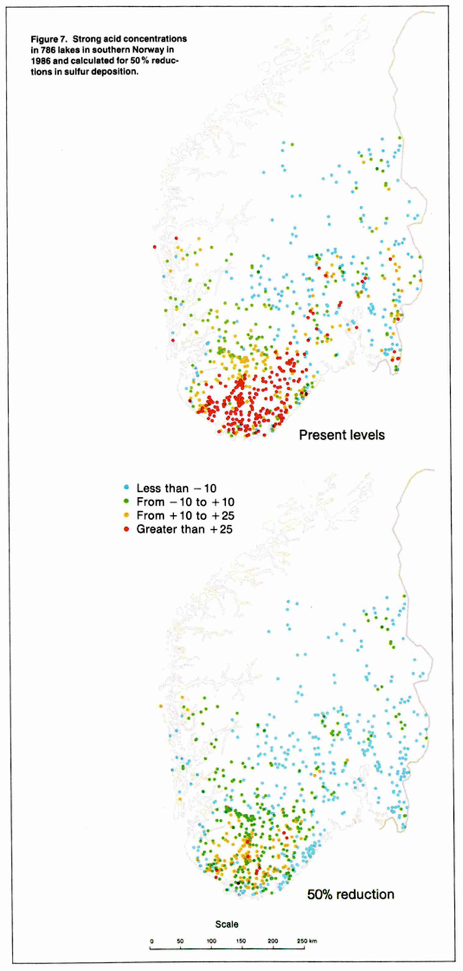Acidification of inland waters
Published in Sustainability

Poster: The site of the sea salt experiment 1000 m above the Sognefjord. Dick Wright and crew setting up. David F. Brakke on the far left and Dick Wright next to David. Photo taken by Steve Norton
Today, more than half a century after the discovery of widespread acidification by fossil fuel combustion, there has been substantial progress in the reduction of emissions of acidifying sulfur and nitrogen oxides, and gradual recovery of the chemistry and biology of inland waters. Liming to restore pH and acid neutralizing capacity has been successful in protecting populations of fish and other organisms. The early reports in Ambio provide an exciting window into the history of the science of acidification of lakes and rivers and were important steps towards these successes.

David F. Brakke
P.O. Box 113, Pt. Clyde, ME 04855, USA.
E-mail: brakkedf@jmu.eduBehind the paper: Tusen: A thousand lakes in the Norwegian landscape
It was the loss of fish populations that signaled something was happening to the lakes in Norway and triggered a long series of very high quality surveys and experiments by an amazing group of scientists at the Norwegian Institute for Water Research. The empirical observations helped stimulate other research in many countries to understand the acidification impacts of air pollution on aquatic ecosystems. The Norwegian lake survey in 1986 made the linkage between acid deposition and lake acidification clear.
At the time, other surveys of lakes were being conducted, including the Eastern and Western Lake Surveys in the United States, in which I was also involved, and a notable survey of lakes in Finland. The surveys in the U.S. were designed to answer a simple question from the Administrator of the U.S. Environmental Protection Agency at the time, Bill Ruckeleshaus, on “how many acidic lakes are there in the Adirondacks?” No one could give him an answer. The surveys were conducted in consecutive years and produced many important results.
After the two U.S. surveys were done, I had a sabbatical leave opportunity from my university. With a fellowship from the Royal Norwegian Academy of Sciences I was able to spend a very special year at NIVA. I had been in Norway for a sampling of humic lakes in two different areas of Norway in September and returned in December as the results from the Thousand Lake Survey were coming in. A fellow traveler for the year was Steve Norton, a geochemist from the University of Maine. Coffee conversations led to many publications and other analyses, including an experimental demonstration of the sea-salt effect in a small catchment located 1000 m above the Sognefjord led by Dick Wright. I should note that not all of the discussions were serious. One of the acknowledgements in one of the published papers was to Glen F. Iddich.
The results of the Norwegian lake survey in 1986 were plotted in colored point maps. Given the tall and thin shape of the country, projection of the results was difficult. We greatly appreciated how Ambio formatted the report we published such that the results could be viewed across the entire country. The colored dots painted the picture better than our written words. The color blue was chosen to represent the best environmental conditions while green to orange to red indicated increasing impacts of acidic deposition.

Reprint of figure 7 from the original article (Henriksen et al. 1989)
Importantly, it should be noted that the successful combat of acidification is not global. The emissions of sulfur and nitrogen from fossil fuel combustion are falling in Europe and North America, but the trend is opposite in the highly populated regions of Asia. The imminent drastic decrease in the use of fossil fuel that is crucial to address the momentous issue of global warming will also benefit recovery from acidification worldwide.
David F. Brakke
brakkedf@jmu.edu
Henriksen, A., L. Lien, B.O. Rosseland, T.S. Traaen, I.S. Sevaldrud, and D.F. Brakke. 1989. Lake acidification in Norway – present and predicted chemical status. Ambio 17: 259-266.
All articles in Ambio's 50th Anniversary Collection on acidification:
Editorial
Tranvik, L. 2021. Acidification of inland waters. 50th Anniversary Collection: Acidification. Ambio volume 50.
Behind the paper
Almer, N., and W. Dickson. 2021. The discovery and early study of acidification of lakes in Sweden. 50th Anniversary Collection: Acidification. Ambio volume 50.
Brakke, D.F. 2021. Tusen: A thousand lakes in the Norwegian landscape. 50th Anniversary Collection: Acidification. Ambio volume 50.
Perspective
Likens, G. 2021. Ambio's legacy on monitoring, impact, and management of acid rain. 50th Anniversary Collection: Acidification. Ambio volume 50.
Rosseland, B.O. 2021. The legacy from the 50 years of acid rain research forming present and future research and monitoring of ecosystem impact. 50th Anniversary Collection: Acidification. Ambio volume 50.





Please sign in or register for FREE
If you are a registered user on Research Communities by Springer Nature, please sign in